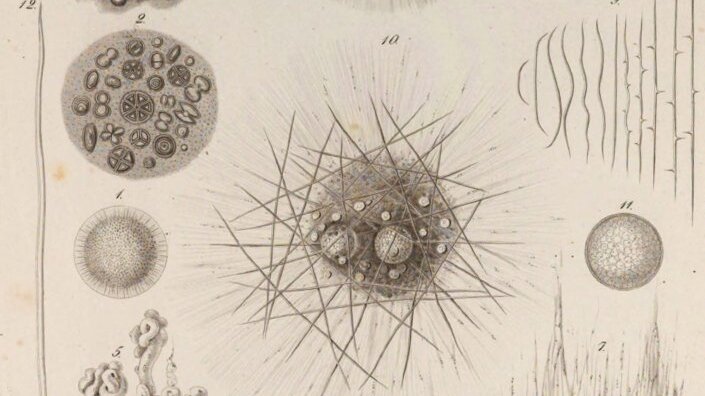... A research workshop on Ernst Haeckel's radiolarian illustrations in the master's program in history of science
As part of the master's seminar "... Tiere, die aussehen wie lauter feine Kunstwerke: Forschungswerkstatt zu Ernst Haeckels Radiolarienabbildungen" (Animals that look like fine works of art: Research workshop on Ernst Haeckel's radiolarian illustrations), students of history of science and history of art investigated the genesis of the illustrations for Ernst Haeckel's monograph on radiolarians.
Radiolarians are unicellular plankton organisms that occur in seawater. They owe their name radiolarians (lat. radiolus - small ray) to their glassy, filigree skeletons. The Jena zoologist Ernst Haeckel not only described numerous new species in his Radiolaria monograph of 1862, but also included an extensive volume with illustrations of the skeletal structures. He made the drawings and the Berlin engraver Wilhelm Wagenschieber transferred them into graphics.
Detail of plate III from Haeckel's pictorial atlas on radiolarians (1862).
Picture: Digitalisat: Münchner DigitalisierungszentrumOn the basis of secondary literature and archival materials of the Ernst-Haeckel-Haus, the seminar participants tried to reconstruct the process of creation of the radiolarian illustrations. They took a closer look at Haeckel's research trips and practices of collecting, microscopy, and classification, but also at the production of radiolarian preparations and the production of the prints. In particular, the close link between Haeckel's artistic and scientific working methods was to be traced.
The research workshop visited the preparator Bernhard Bock in the Phyletisches Museum, who demonstrated drawing on the microscope using a prism device, and afterwards the seminar participants were able to practically reproduce Ernst Haeckel's drawing practices themselves.
Microscope with a Camera Lucida (device with prism) for drawing preparations
Image: Bastienne Karg